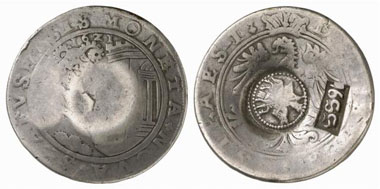Schaffhausen and Russia
In 1654 Aleksey Mikhailovich started a monetary reform: the rouble divided into 100 kopecks was introduced. The new coins were made of foreign talers purchased from merchants for 48 to 50 kopecks. Hence derived the vernacular name jefímok, or taler struck in Joachimstal (Polish ‘joachimki’).
Jefímok, Schaffhausen, taler 1621. MONETA NOVA SCAFVSENSIS. Ram jumping from a tower to left. Rv. DEVS SPES NOSTRA EST Eagle, above crown. On the obverse two countermarks: tsar with spear riding to the right, indication of the year 1655. (Wiel. 708). Copyright Sturzenegger Stiftung / Museum zu Allerheiligen Schaffhausen.
The first attempts to restrike the coins completely failed. For this reason, in 1655 they fell back on countermarking, a technically much simplier way of solving this issue. One of the two punches shows the tsar riding with a spear and the mark ‘M’ which indicates the Moscow mint. The other punch gives the year 1655 the very year when the coins were countermarked. The new coins were counted to be worth 64 kopecks which actually corresponded to their average value. Already four years later, in 1659 Russia demonetised the jefímki (this is the plural of jefímok) melting them into kopecks. Anyway, in the rest of Eastern Europe they continued still to circulate until the nineteenth century as we know from coin findings.
Jefímok, Schaffhausen, taler 1621. From Künker Auction 148 (2009), 1007.
Even the ‘common’ jefímki made of German or Dutch talers are rare. But yet much scarcer Swiss talers found their way to the remote Russia where they were countermarked and re-used. Until recently the collection’s curator knew only of one single specimen, the one pictured above. However, in 2004 and 2009 two other specimens were offered in auction, one from the Antonin Prokop Collection (Künker 148 (2009), 1007), the other from the Fuchs Collection (Hess-Divo AG 300 (2004), 1231).











